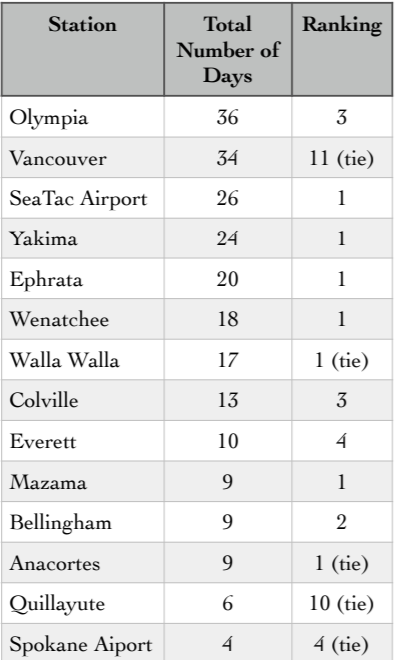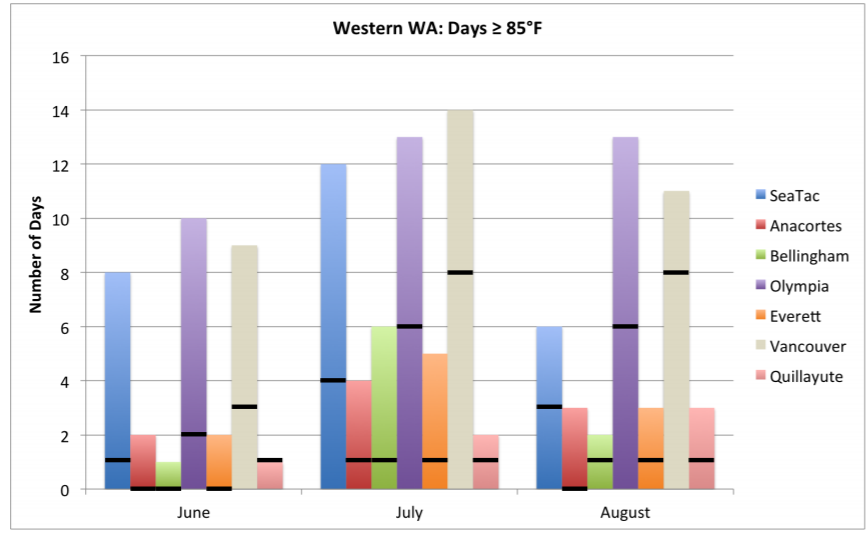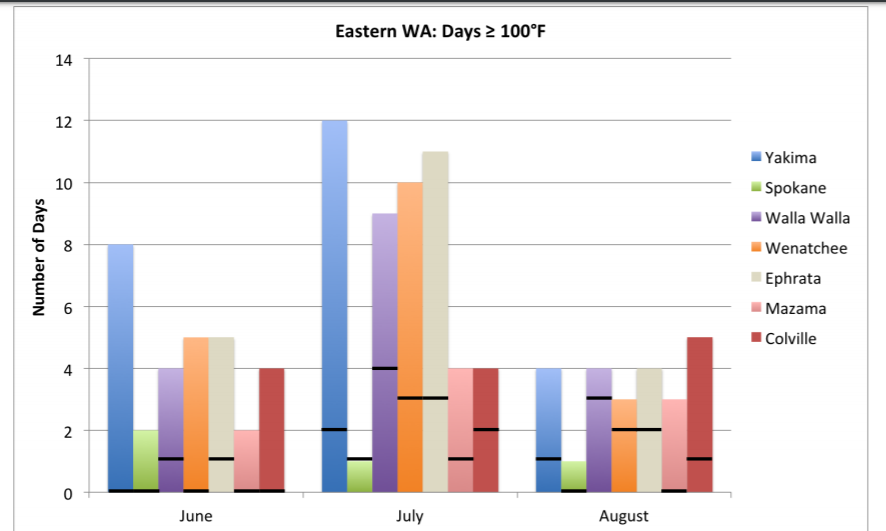Review of Summer 2015: Increased Number of Hot Days
October, 2015
2015 has so far been much warmer than normal for Washington State, with January through August ranking as the warmest on record. The summer (defined as June through August) was also warm and set records as the warmest summer for the state, with temperatures 4.5°F above the 30-yr (1981-2010) normal when averaged statewide (Fig. 1). But how did the summer shape up on the daily time scale? This spotlight piece reviews the number of hot days at selected stations around the state, and how that fits in with the historical record.

June-August (JJA) average temperatures were quite remarkable for the state, as evidenced by the way 2015 stands out on Fig 1, even beating out the notorious warm summer of 1934 during the period of the Dust Bowl. It is worth noting that JJA maximum temperatures (5.2°F above normal) and minimum temperatures (3.6°F above normal) also ranked as the warmest on record averaged over the state. Precipitation (Fig 1), while ranking as the 9th driest statewide with a deficit of 1.98”, appears less drastic, due to the fact that it is a normally dry time of year and thus has less interannual variability. The warm temperatures are the focus here.

Figure 2 shows the number of days in June, July, and August that were 85°F or above for 7 western WA stations, with the long-term climatological average number of days for each station and month represented by the horizontal black lines. The total number of warm days varied between 6 and 36 for this set of stations, with rankings that ranged as the most on record (SeaTac Airport and Anacortes) to tied for 10th (Quillayute) and 11th (Vancouver) place (Table 1). SeaTac Airport’s 26 days with temperatures of at least 85°F beat out last year, which was also warm with 22 days, and the warm summer of 1967. On average, SeaTac Airport usually has 9 days of temperatures 85°F or above. Bellingham usually sees about 2 days reaching this threshold, but had 9 in 2015, only shy of the record of 14 days in the summer of 1958.
The number of days with temperatures 90°F or above this past summer in western WA is also record-breaking for some stations (not shown). SeaTac Airport, for example, had a record with 12 days of temperatures 90°F or above. The previous record was 9 days in 1958. At Quillayute, 2015 tied for 3rd place with 3 days 90°F or above; it typically only sees 1 day each summer with such warm temperatures. Olympia Airport had an impressive 17 days 90°F or above, which was a close 2nd to the 18 days in 1967. Other locations, such as Bellingham, Anacortes, and Everett only had 1 day above 90°F (July 5, July 20, and July 20, respectively), and thus didn’t set any records. Though the mercury didn’t creep up to 90°F often in Anacortes this summer, the number of days 85°F or above did tie for first place with 9 days, evidence of the nearby water moderating the temperatures to a certain extent.


and days above 100°F.
The temperatures and the rankings of warm summer days was much more impressive for stations east of the Cascades. Figure 3 shows the number of days with maximum temperatures at or exceeding 100°F for 7 eastern WA stations with the long-term climatological average illustrated by the black lines. The total number of days ranged from 4 to 24, with Yakima and Ephrata having the most with 24 and 20 days, respectively (Table 1). Five of these stations had the highest number of days at 100°F or above on record (Yakima, Walla Walla, Wenatchee, Ephrata, and Mazama) or tied for the summer. Spokane Airport typically has 1 100°F day per summer, but tied for 4th place this year with 4 days. A larger deviation from normal can be seen with Colville; this summer saw 13 days (3rd place) with 100°F or above. That kind of heat occurs on only about 3 days in a typical summer.
Many of the stations, both west and east of the Cascades, had their highest number of hot days in July, which isn’t too much of a surprise since that’s the climatological peak over the period of record as well. Relative to normal, June is actually the more impressive month in terms of days getting hotter than usual. For stations across the entire state, the number of hot days was higher than usual for the whole summer and the mean summer temperature was higher than normal as well. This unusually hot weather exacerbated the drought in WA, with substantial impacts on agriculture and wildfires, among other effects.
